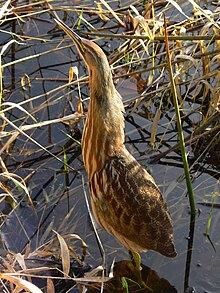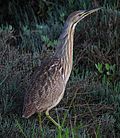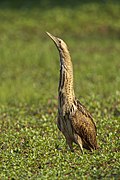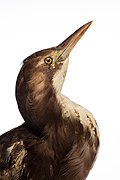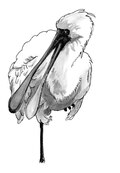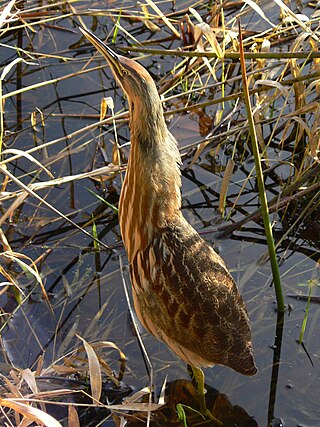
The American bittern is a species of wading bird in the heron family. It has a Nearctic distribution, breeding in Canada and the northern and central parts of the United States, and wintering in the U.S. Gulf Coast states, all of Florida into the Everglades, the Caribbean islands and parts of Central America.
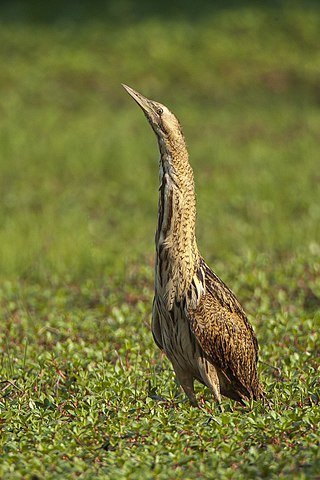
The Eurasian bittern or great bittern is a wading bird in the bittern subfamily (Botaurinae) of the heron family Ardeidae. There are two subspecies, the northern race breeding in parts of Europe and across the Palearctic, as well as on the northern coast of Africa, while the southern race is endemic to parts of southern Africa. It is a secretive bird, seldom seen in the open as it prefers to skulk in reed beds and thick vegetation near water bodies. Its presence is apparent in the spring, when the booming call of the male during the breeding season can be heard. It feeds on fish, small mammals, fledgling birds, amphibians, crustaceans and insects.
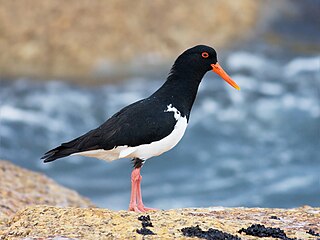
The oystercatchers are a group of waders forming the family Haematopodidae, which has a single genus, Haematopus. They are found on coasts worldwide apart from the polar regions and some tropical regions of Africa and South East Asia. The exceptions to this are the Eurasian oystercatcher, the South Island oystercatcher, and the Magellanic oystercatcher, which also breed inland, far inland in some cases. In the past there has been a great deal of confusion as to the species limits, with discrete populations of all black oystercatchers being afforded specific status but pied oystercatchers being considered one single species.

The Eurasian hobby or just hobby, is a small, slim falcon. It belongs to a rather close-knit group of similar falcons often considered a subgenus Hypotriorchis.

Herons are long-legged, long-necked, freshwater and coastal birds in the family Ardeidae, with 72 recognised species, some of which are referred to as egrets or bitterns rather than herons. Members of the genera Botaurus and Ixobrychus are referred to as bitterns, and, together with the zigzag heron, or zigzag bittern, in the monotypic genus Zebrilus, form a monophyletic group within the Ardeidae. Egrets do not form a biologically distinct group from herons, and tend to be named differently because they are mainly white or have decorative plumes in breeding plumage. Herons, by evolutionary adaptation, have long beaks.

The woodcocks are a group of seven or eight very similar living species of wading birds in the genus Scolopax. The genus name is Latin for a snipe or woodcock, and until around 1800 was used to refer to a variety of waders. The English name is first recorded in about 1050. According to the Harleian Miscellany, a group of woodcocks is called a "fall".

The curlews are a group of nine species of birds in the genus Numenius, characterised by their long, slender, downcurved bills and mottled brown plumage. The English name is imitative of the Eurasian curlew's call, but may have been influenced by the Old French corliu, "messenger", from courir , "to run". It was first recorded in 1377 in Langland's Piers Plowman "Fissch to lyue in þe flode..Þe corlue by kynde of þe eyre". In Europe, "curlew" usually refers to one species, the Eurasian curlew.

The garganey is a small dabbling duck. It breeds in much of Europe and across the Palearctic, but is strictly migratory, with the entire population moving to Africa, India, Bangladesh and Australasia during the winter of the Northern hemisphere, where large flocks can occur. This species was first described by Carl Linnaeus in his landmark 1758 10th edition of Systema Naturae. Like other small ducks such as the Eurasian teal, this species rises easily from the water with a fast twisting wader-like flight.

Coots are medium-sized water birds that are members of the rail family, Rallidae. They constitute the genus Fulica, the name being the Latin term for "coot". Coots have predominantly black plumage, and—unlike many rails—they are usually easy to see, often swimming in open water.

The Eurasian curlew or common curlew is a very large wader in the family Scolopacidae. It is one of the most widespread of the curlews, breeding across temperate Europe and Asia. In Europe, this species is often referred to just as the "curlew", and in Scotland known as the "whaup" in Scots.

The Eurasian or common whimbrel, also known as the white-rumped whimbrel in North America, is a wader in the large family Scolopacidae. It is one of the most widespread of the curlews, breeding across much of subarctic Asia and Europe as far south as Scotland. This species and the Hudsonian whimbrel have recently been split, although some taxonomic authorities still consider them to be conspecific.

The red phalarope or grey phalarope is a small wader. This phalarope breeds in the Arctic regions of North America and Eurasia. It is migratory, and, unusually for a wader, migrates mainly on oceanic routes, wintering at sea on tropical oceans.

The parasitic jaeger or Arctic skua (Europe), is a seabird in the skua family Stercorariidae. It is a migratory species that breeds in Northern Scandinavia, Scotland, Iceland, Greenland, Northern Canada, Alaska, and Siberia and winters across the southern hemisphere. Kleptoparasitism is a major source of food for this species during migration and winter, and is where the name is derived from.

The Eurasian dotterel, also known in Europe as just dotterel, is a small wader in the plover family of birds. It is the only species placed in the genus Eudromias.

The little curlew is a wader in the large bird family Scolopacidae. It is a very small curlew, which breeds in the far north of Siberia. It is closely related to the North American Eskimo curlew.

The cinnamon bittern or chestnut bittern is a small Old World bittern, breeding in tropical and subtropical Asia from India east to China and Indonesia. It is mainly resident, but some northern birds migrate short distances.

Ixobrychus is a genus of bitterns, a group of wading bird in the heron family Ardeidae. It has a single representative species in each of North America, South America, Eurasia, and Australasia. The tropical species are largely resident, but the two northern species are partially migratory, with many birds moving south to warmer areas in winter.

The least bittern is a small heron, the smallest member of the family Ardeidae found in the Americas.

Lanius, the typical shrikes, are a genus of passerine birds in the shrike family Laniidae. The majority of the family's species are placed in this genus. The genus name, Lanius, is derived from the Latin word for "butcher", and some shrikes are also known as "butcher birds" because of their feeding habits. The common English name "shrike" is from Old English scríc, "shriek", referring to the shrill call.

The pinnated bittern, also known as the South American bittern, is a large member of the heron family (Ardeidae) found in the New World tropics. Like the other Botaurus bitterns, its plumage is mostly buffy-brown and cryptically patterned. Though it is a widespread species, it is rarely seen – presumably due to its skulking habits – and much about its life history remains little known.
